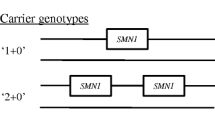Abstract
We examined families with a history of spinal and bulbar muscular atrophy (SBMA) and found that six out of eight female carriers had a skewed inactivation of the wild-type chromosome. Under these genetic conditions, disease manifestations should be expected and therefore we sought neurological and other symptoms of subclinical SBMA. We did not find either clinical symptoms or electrophysiological signs of mutated AR gene in female carriers, despite skewed methylation of the wild-type allele. These findings suggest that skewed methylation of AR genes are not necessarily associated to clinical manifestations in female carriers of the expanded SBMA allele.
Similar content being viewed by others
References
Kennedy WR, Alter M, Sung JH (1968) Progressive proximal spinal and bulbar muscular atrophy of late onset: a sex linked recessive trait. Neurology 18:671–680
La Spada AR, Wilson EM, Lubahn DB, Harding AE, Fischbeck KH (1991) Androgen receptor gene mutations in X-linked spinal and bulbar muscular atrophy. Nature 352:77–79
Azofeifa J, Voit T, Hubner C, Cremer M (1995) X-chromosome methylation in manifesting carriers of dystrophinopathies: concordance of activation ratios among first degree female relatives and skewed inactivation as cause of the affected phenotypes. Hum Genet 96:167–176
Kristiansen M, Knudsen GP, Tanner SM, McEntagart M, Jungbluth H, Muntoni F, Sewry C, Gallati S, Orstavik KH, Wallgren-Pettersson C (2003) X-inactivation patterns in carriers of X-linked myotubular myopathy. Neuromuscul Disord 13:468–471
Mariotti C, Castellotti B, Pareyson D, Testa D, Eoli M, Antozzi C, Silani V, Marconi R, Tezzon F, Siciliano G, Mar-chini C, Gellera C, Donato SD (2000) Phenotypic manifestations associated with CAG-repeat expansion in the androgen receptor gene in male patients and heterozygous females: a clinical and molecular study of 30 families. Neuromusc Dis 10:391–397
Ishihara H, Kanda F, Nishio H, Sumino K, Chihara K (2001) Clinical features and skewed X-chromosome inactivation in female carriers of X-linked recessive spinal and bulbar muscular atrophy. J Neurol 248:856–860
Sobue G, Doyu M, Kachi T, Yasuda T, Mukai E, Kumagai T, Mitsuma T (1993) Subclinical phenotypic expressions in heterozygous females of X-linked recessive bulbospinal neuronopathy. J Neuro Sci 117:74–78
Chen RS, Huang CC, Chu NS, Cheng CC, Wei YH (1999) Random X chromosome methylation patterns in the carriers with clinical phenotypic expressions of X-linked recessive bulbospinal neuronopathy. 1: Acta Neurol Scand 100:249–253
Allen RC, Zoghbi HY, Moseley AB, Rosenblatt HM, Belmont JW (1992) Methylation of Hpa II and Hha I sites near the polymorphic CAG repeat in the human androgen-receptor gene correlates with X-chromosome inactivation. Am J Hum Genet 51:1229–1239
Martinez R, Bonilla-Henao V, Jimenez A, Lucas M, Vega C, Ramos I, Sobrino F, Pintado E (2005) Skewed X inactivation of the normal allele in fully mutated female carriers determines the levels of FMRP in blood and the fragile X phenotype. Molecular Diagnosis 9:157–162
Pegoraro E, Schimke RN, Arahata K, Hayashi Y, Stern H, Marks H, Glasberg MR, Caroll JE, Taber JW, Wessel HB, Bauserman SC, Marks WA, Toriello HV, Higgins JV, Appleton S, Schwartz L, Garcia CA, Hoffman EP (1994) Detection of new paternal dystrophin gene mutations in isolated cases of dystrophinopathy in females. Am J HumGenet 54:989–1003
Andreu N, Pujol-Moix N, Martinez- Lostao L, Oset M, Muniz-Diaz E, Estivill X, Volpini V, Fillat C (2003) Wiskott-Aldrich syndrome in a female with skewed X-chromosome inactivation. Blood Cells Mol Dis 31:332–337
Migeon BR, Haisley-Royster C (1998) Familial skewed X inactivation and X-linked mutations: unbalanced X inactivation is a powerful means to ascertain X-linked genes that affect cell proliferation. Am J Hum Genet 62:1555–1557
Evert BO, Wüllner U, Klockgether T (2000) Cell death in polyglutamine diseases. Cell and Tissue Research 301:189–204
Author information
Authors and Affiliations
Corresponding author
Rights and permissions
About this article
Cite this article
Paradas, C., Solano, F., Carrillo, F. et al. Highly skewed inactivation of the wild-type X-chromosome in asymptomatic female carriers of spinal and bulbar muscular atrophy (Kennedy’s disease). J Neurol 255, 853–857 (2008). https://doi.org/10.1007/s00415-008-0766-1
Received:
Revised:
Accepted:
Published:
Issue Date:
DOI: https://doi.org/10.1007/s00415-008-0766-1




